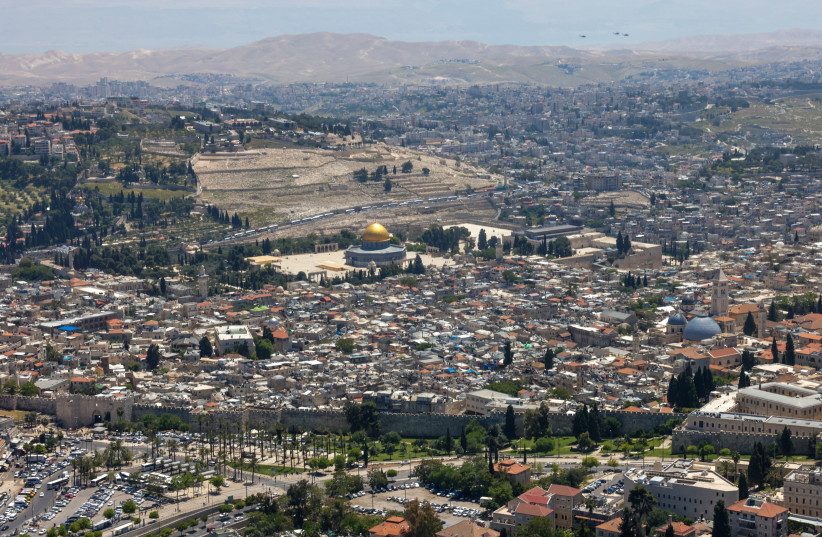Jerusalem Day: The statistics of Israel’s capital
As every year, the Jerusalem Institute for Policy Research published its Yearbook with data that paints as recent a picture of Jerusalem as possible. Although reflective of the previous year (in this case, 2021 -2022), the data serves to provide a picture of emerging trends over the years.
The good news is that Jerusalem has recovered from COVID-19. As a result, in 2022 foreign tourism doubled from 2021, while hotel occupancy increased from 22% to 55%.
The renewal in tourism – a major source of employment for the Arab sector – led to a sharp increase in the participation of Arab Israeli men in the workforce in 2022, bringing figures to 81% of this sector of the population.
Figures of Jerusalem’s population
The capital’s total population reached a grand total of 966,200, doubling that of Tel Aviv. Meanwhile, metropolitan Jerusalem continued to grow, with more than 1.4 million residents spread over 80 neighborhoods. Figures for new immigrants choosing to make their home in Jerusalem reached 14% in 2022 (totaling 3,700) – slightly over the 13% who opted for Tel Aviv.
In 2021, Jerusalem had 590,600 Jewish residents; 375,600 Arab residents (362,600 were Muslim and 12,900 Christian); 3,500 non-Arab Christian residents; and a further 10,500 residents who opted for no classification.
 JERUSALEM: A view of Israel’s capital city (Illustrative). (credit: MARC ISRAEL SELLEM)
JERUSALEM: A view of Israel’s capital city (Illustrative). (credit: MARC ISRAEL SELLEM)Of the city’s 322,800 Jewish residents aged 20 and older, 19% identified as secular (62,400 residents); 25% as traditional (81,800); 20% as religiously observant (65,600); and 35% as haredi (113,100). The haredi sector in 2022 accounted for 48% of Jerusalem’s Jewish population, and 29% of its total population.
The average birthrate among Jerusalem’s Jewish women was 4.4 in 2022, and the birthrate among its Arab women was 3.1. The discrepancy is attributable to high birthrates in the city’s haredi and religiously observant populations, and to a decline in the birthrates among Arab women in Jerusalem (as well as in other parts of the country).
In 2021, a total of 11,900 Israeli residents from other areas moved to Jerusalem, marking an increase relative to 2020. Of the newcomers, 24% (2,800 residents) moved from Judea and Samaria, and 36% (4,300 residents) from localities in central Israel. Among these, 42% (5,000 residents) were aged 20-29.
Conversely, in 2021 a total of 22,700 residents left Jerusalem – compared to 18,800 who moved away from the capital in 2020. Nevertheless, approximately 50% of the migration was to localities in the surrounding metropolitan area that maintain employment-based, economic and educational relations with the city.
Jerusalem’s net migration balance (including new immigrants, residents leaving for – or arriving from – overseas, and family reunification) stood at negative 6,600 in 2021.
In 2022, labor force participation rate among all Jerusalem residents of traditional working age (25-64) was 67% – contrasting with 82% in the entire country. Among men alone, the figures were 74% for Jerusalem and 85% for all of Israel.
The low labor force participation rate among Jerusalem men in general is attributable to the limited employment rate among haredi men – 45%. Among Jerusalem women, the labor force participation rate stood at 60% (as compared to 79% for the whole country). This low rate among Jerusalem women is attributable to the scant employment rate among Arab women, at 27%.
The main economic employment sectors in Jerusalem are education, which accounts for 18% of jobs; human health and social work services – 15%; local and public administration – 10%. Six percent of Jerusalemites worked in hi-tech, compared to 20% of Tel Avivians.
ON THE other hand, as CEO of the Institute, David Koren said: “One must not ignore worrying trends that emerge from the Yearbook, such as the city’s high poverty rate.”
“One must not ignore worrying trends that emerge from the Yearbook, such as the city’s high poverty rate.”
David Koren
These figures were significantly higher in Jerusalem than the country’s overall poverty rate. In 2021, 39% of Jerusalem’s families (125,900) lived below the poverty line. According to the Israeli Central Bureau of Statistics 2019-2021 social survey, one-third of the city’s population are children between the ages of 0-14. Half of these children (202,400) lived in poverty last year. Among Jerusalem’s haredi population, 43% lived below the poverty line, a slightly higher figure than the general poverty rate among the entire state’s haredi population (40%.) Among Jerusalem’s Arabs, 60% lived below the poverty line – compared to 39% in 2020.
In 2022, a record 7,300 construction permits were issued in Jerusalem.
The average price of a Jerusalem apartment of three and a half to four rooms was NIS 2,777,800 in 2022 – a 16% increase over 2021. Haifa apartments averaged much less, at NIS 1,610,300; and Tel Aviv was much more costly, at NIS 4,643,700. The overall average for such an apartment in the entire country was NIS 1,885,500. ❖
The 37th Yearbook of The Jerusalem Institute for Policy Research was presented by CEO David Koren, and Data Analysis and Services head Yair Assaf-Shapira.





Comments are closed.